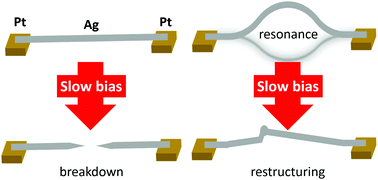Current-induced restructuring in bent silver nanowires†
Abstract
A number of metallic one-dimensional nanostructures have been proposed as interconnects for next-generation electronic devices. Generally, reports on charge transport properties consider low current density regimes in nanowires (or nanotubes) with intrinsically straight configurations. In these circumstances, direct observations of the interconnecting nanofilament electrical failure are scarce, particularly for initially crooked structures. Here, the electrical and structural responses of suspended silver nanowires exposed to increasing current densities were analysed using in situ transmission electron microscopy. At low rates of bias application, initially straight nanowires showed trivial behaviour up to their breakdown, with electromigration and gradual necking taking place. By contrast, these nanowires with an initially crooked configuration exhibit a mixed set of responses which included string-like resonance and structural rearrangements. Remarkably, it was observed that restructuring does not necessarily compromise the transport function of these interconnectors. Hence, initially crooked nanowires could import higher resilience to future nanoelectronic devices by delaying catastrophic breakdown of interconnectors subjected to unexpected current surges.



 Please wait while we load your content...
Please wait while we load your content...